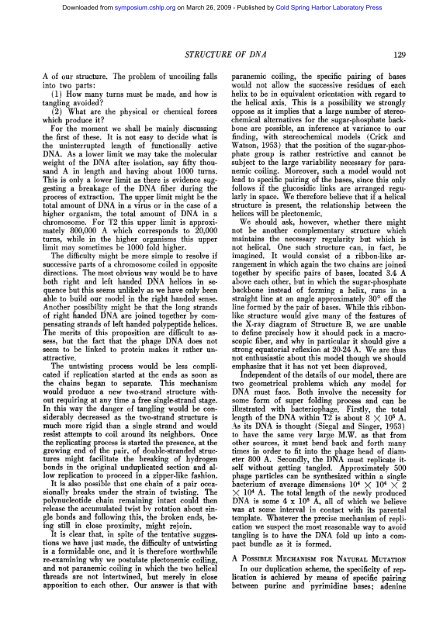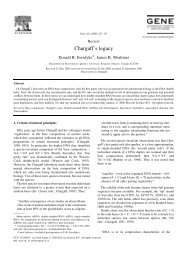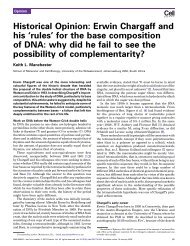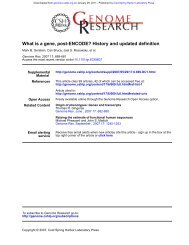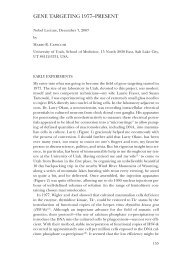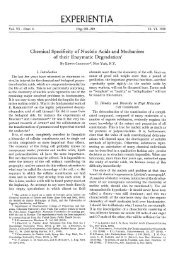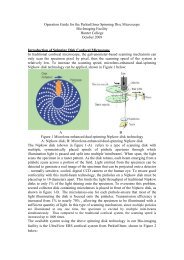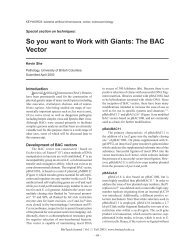Cold Spring Harb Symp Quant Biol-1953-Watson-SQB ... - Biology
Cold Spring Harb Symp Quant Biol-1953-Watson-SQB ... - Biology
Cold Spring Harb Symp Quant Biol-1953-Watson-SQB ... - Biology
Create successful ePaper yourself
Turn your PDF publications into a flip-book with our unique Google optimized e-Paper software.
Downloaded from symposium.cshlp.org on March 26, 2009 - Published by <strong>Cold</strong> <strong>Spring</strong> <strong>Harb</strong>or Laboratory Press<br />
STRUCTURE OF DNA 129<br />
A of our structure. The problem of uncoiling fails<br />
into two parts:<br />
(1) How many turns must be made, and how is<br />
tangling avoided?<br />
(2) What are the physical or chemical forces<br />
which produce it?<br />
For the moment we shall be mainly discussing<br />
the first of these. It is not easy to decide what is<br />
the uninterrupted length of functionally active<br />
DNA. As a lower limit we may take the molecular<br />
weight of the DNA after isolation, say fifty thousand<br />
A in length and having about 1000 turns.<br />
This is only a lower limit as there is evidence suggesting<br />
a breakage of the DNA fiber during the<br />
process of extraction. The upper limit might be the<br />
total amount of DNA in a virus or in the case of a<br />
higher organism, the total amount of DNA in a<br />
chromosome. For T2 this upper limit is approximately<br />
800,000 A which corresponds to 20,000<br />
turns, while in the higher organisms this upper<br />
limit may sometimes be 1000 fold higher.<br />
The difficulty might be more simple to resolve if<br />
successive parts of a chromosome coiled in opposite<br />
directions. The most obvious way would be to have<br />
both right and left handed DNA helices in sequence<br />
but this seems unlikely as we have only been<br />
able to build our model in the right handed sense.<br />
Another possibility might be that the long strands<br />
of right handed DNA are joined together by compensating<br />
strands of left handed polypeptide helices.<br />
The merits of this proposition are difficult to assess,<br />
but the fact that the phage DNA does not<br />
seem to be linked to protein makes it rather unattractive.<br />
The untwisting process would be less complicated<br />
if replication started at the ends as soon as<br />
the chains began to separate. This mechanism<br />
would produce a new two-strand structure without<br />
requiring at any time a free single-strand stage.<br />
In this way the danger of tangling would be considerably<br />
decreased as the two-strand structure is<br />
much more rigid than a single strand and would<br />
resist attempts to coil around its neighbors. Once<br />
the replicating process is started the presence, at the<br />
growing end of the pair, of double-stranded structures<br />
might facilitate the breaking of hydrogen<br />
bonds in the original unduplicated section and allow<br />
replication to proceed in a zipper-like fashion.<br />
It is also possible that one chain of a pair occasionally<br />
breaks under the strain of twisting. The<br />
polynucleotide chain remaining intact could then<br />
release the accumulated twist by rotation about single<br />
bonds and following this, the broken ends, being<br />
still in close proximity, might rejoin.<br />
It is clear that, in spite of the tentative suggestions<br />
we have just made, the di~eulty of untwisting<br />
is a formidable one, and it is therefore worthwhile<br />
re-examining why we postulate plectonemic coiling,<br />
and not paranemic coiling in which the two helical<br />
threads are not intertwined, but merely in close<br />
apposition to each other. Our answer is that with<br />
paranemic coiling, the specific pairing of bases<br />
would not allow the successive residues of each<br />
helix to be in equivalent orientation with regard to<br />
the helical axis. This is a possibility we strongly<br />
oppose as it implies that a large number of stereochemical<br />
alternatives for the sugar-phosphate backbone<br />
are possible, an inference at variance to our<br />
finding, with stereochemical models (Crick and<br />
<strong>Watson</strong>, <strong>1953</strong>) that the position of the sugar-phosphate<br />
group is rather restrictive and cannot be<br />
subject to the large variability necessary for paranemic<br />
coiling. Moreover, such a model would not<br />
lead to specific pairing of the bases, since this only<br />
follows if the glucosidic links are arranged regularly<br />
in space. We therefore believe that if a helical<br />
structure is present, the relationship between the<br />
helices will be plectonemic.<br />
We should ask, however, whether there might<br />
not be another complementary structure which<br />
maintains the necessary regularity but which is<br />
not helical. One such structure can, in fact, be<br />
imagined. It would consist of a ribbon-like arrangement<br />
in which again the two chains are joined<br />
together by specific pairs of bases, located 3.4 A<br />
above each other, but in which the sugar-phosphate<br />
backbone instead of forming a helix, runs in a<br />
straight line at an angle approximately 30 ~ off the<br />
line formed by the pair of bases. While this ribbonlike<br />
structure would give many of the features of<br />
the X-ray diagram of Structure B, we are unable<br />
to define precisely how it should pack in a macroscopic<br />
fiber, and why in particular it should give a<br />
strong equatorial reflexion at 20-24 A. We are thus<br />
not enthusiastic about this model though we should<br />
emphasize that it has not yet been disproved.<br />
Independent of the details of our model, there are<br />
two geometrical problems which any model for<br />
DNA must face. Both involve the necessity for<br />
some form of super folding process and can be<br />
illustrated with bacteriophage. Firstly, the total<br />
length of the DNA within T2 is about 8 X 105 A.<br />
As its DNA is thought (Siegal and Singer, <strong>1953</strong>)<br />
to have the same very large M.W. as that from<br />
other sources, it must bend back and forth many<br />
times in order to fit into the phage head of diameter<br />
800 A. Secondly, the DNA must replicate itself<br />
without getting tangled. Approximately 500<br />
phage particles can be synthesized within a single<br />
bacterium of average dimensions 104 X 104 X 2<br />
X 104 A. The total length of the newly produced<br />
DNA is some 4 x l0 s A, all of which we believe<br />
was at some interval in contact with its parental<br />
template. Whatever the precise mechanism of replication<br />
we suspect the most reasonable way to avoid<br />
tangling is to have the DNA fold up into a compact<br />
bundle as it is formed.<br />
A POSSIBLE MECHANISM FOR NATURAL MUTATION<br />
In our duplication scheme, the specificity of replication<br />
is achieved by means of specific pairing<br />
between purine and pyrimidine bases; adenine


